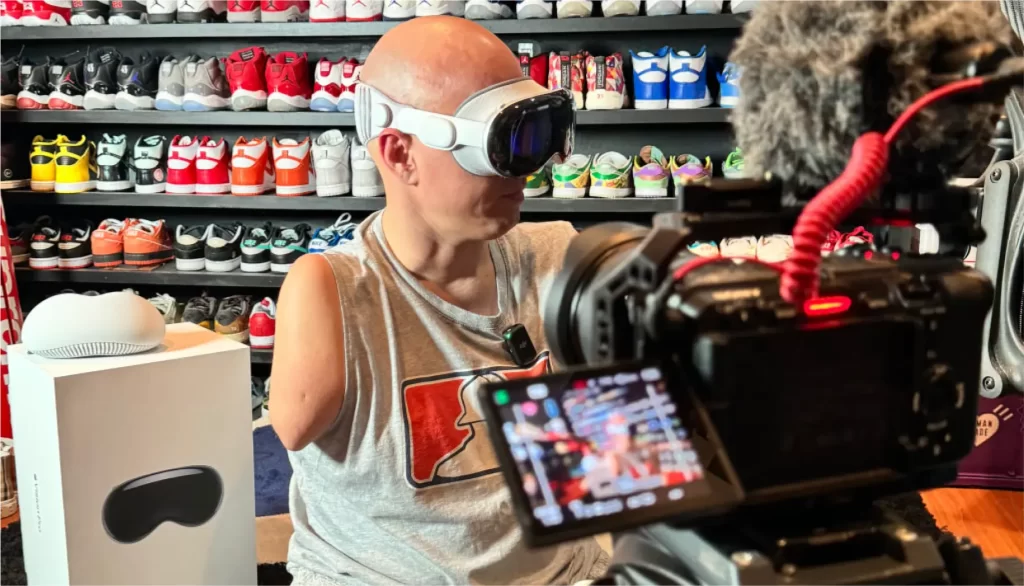Image of man missing hands wearing an Apple Vision Pro.
Apple launched the Apple Vision Pro on February 2nd, aiming to revolutionize work, play, and interaction. It has the potential to greatly impact people with disabilities, allowing them to experience activities they may not otherwise be able to do. I personally reached out to Tim Cook to express my enthusiasm and share some concerns about button placement and the significance of accessibility. Shortly after, I received the below email from Apple’s Accessibility Team.
“Thank you for your email! We are glad to know you are excited about the Apple Vision Pro.
Because accessibility is a core value for us, the Apple Vision Pro comes with dozens of accessibility features built into its foundation from the very start, including VoiceOver for users who are blind or have low vision, Voice Control and Switch Control for users with physical and motor disabilities, and support for Made for iPhone hearing devices for users who are Deaf or hard of hearing.
Additionally, users with disabilities can interact with the Vision Pro entirely with their eyes, their hands, their voice, or a combination that works best for them. Vision Pro includes the option to utilize eye tracking with one dominant eye, and users can also select their index finger, wrist, or head as an alternative to eye input.”
After reading this email, I was even more excited to get one!
On the day of the pre-order, I jumped online and got one. The process was pretty easy and, as most things with Apple, extremely accessible. The app took measurements of my head to ensure I was sent the correct size light seal and strap. Now I just wait for it to come.
The box arrived at my door around 5 pm, and I was so excited to open it. I felt like a kid at Christmas waiting to open his gifts.
The Shipping Box
The shipping box was a little bigger than I expected but not too heavy. I immediately noticed the pull tab and bit it and pulled it off. The box was like a transformer and unfolded with very little effort.
Product Box
Like all Apple product boxes these days, the Apple Vision Pro box was not wrapped in plastic, just a box with 2 pull tabs for easy opening. I pulled both tabs and lifted the top pretty easily. And there sat the Apple Vision Pro. It had a few pull tabs around it to remove it from the support. I set it aside and dug in for the batteries. All aspects of this box are extremely accessible. However, I did have some trouble pulling out the battery and its parts because there was nothing to pull them up. I had to turn the box on its side to get them out.
Putting On The Apple Vision Pro
Now that I got it out of the box, I needed to figure out a way to put it on. After a few failed attempts, I figured out a way; I put the front on first and used the wall to pull down the strap. Unfortunately, the light seal shifted (magnet) a bit while pressing it against my head, but I was able to get them on my head. This is not the easiest, but just like with everything, I’m sure I’ll figure out a way to make it easier the more I do it.
(UPDATE: After changing to the dual loop band I was able to put it on and take it off by myself)
Setting Up The Apple Vision Pro
So now that I got it on, it’s time to turn it on and set it up. The only problem is Apple put the button (crown) on the top of the frame, and I can’t reach it. No problem, I’ll take them off and turn it on and put them back on. I’ll be sure to remember to ALWAYS turn them on first. Now they are on, and I begin the setup. The first thing it asks is to “tap the crown to get started” 😞 – Again, because of the crown placement at the top, there’s no way for me to do it. So I call in Noah, my son, to help. He presses the button, and I tell him I should be good now. I mean, Apple’s Accessibility Team assured me that the “Apple Vision Pro comes with dozens of accessibility features built into its foundation from the very start.” Their words, right? But this unfortunately was not the case. In fact, the only accessibility option at this point is “VoiceOver,” and to activate that, I would have to have someone not hit the crown button once but 3 times. At this point, I’m getting pretty frustrated. But on to the next step. “SCAN YOUR HANDS” 😡 and there’s no way around it.
My only option is to call Noah back into the room, and we come up with an idea. Noah sits behind me and reaches his arms out in front of me, and we scan his hands and move onto the next step. This step synchronized my eyes to the Apple Vision Pro. It requires you to look at dots around the screen and use your hands to tap them. So with Noah’s help, we get through it and move on. I next have to set up my profile and link my Apple account. All of these steps require hands with no other way around them. Thankfully, Noah was there to help me. I had to look at whatever I wanted on the device and say “tap” to Noah to tap. This was an awful experience, but thankfully after around 20 minutes, we got through it TOGETHER.
UPDATE: There is an option to turn on certain accessibility features in the set up process unfortunately you still need to be able to tap the buttons on the top of the device)
Accessibility Settings
Setup is done, and I’m able to explore the Apple Vision Pro…still with my left (and right) hand man Noah. Still telling him when to tap while I navigate the interface with my eyes. With Noah’s help, the first thing I did was go into the Accessibility screen in Settings and turn on Voice Control and Assistive Touch. These are the accessibility features I needed “from the start.” But FINALLY, I made it, and I am able to control the Apple Vision Pro by myself.
Interface & Experience
The Apple Vision Pro is incredible. The interface is even more fluid and visually stunning than I had imagined. I navigated around and tried out a few videos, and I was in awe of everything I was experiencing. I jumped into a few immersive videos, and I was in awe. For someone that has never walked more than a few steps in his life to be instantly transported onto a field running with kids, climbing a mountain, and being on the Fenway Park baseball field with players! It gave me chills, and it was exactly what I had hoped it would be. I didn’t continue to use it much more because I was still very frustrated and burnt out from the setup experience. Not to mention, I was getting annoyed having to say “tap” or “scroll” over and over again to navigate. But tomorrow is a new day, and I’ll give it another try.

Conclusion
Apple failed in the setup process. Requiring users who can’t reach the physical buttons on top to have assistance accessing accessibility features. Users who are unable to reach or tap the crown button will unfortunately be disappointed. The missing accessibility features users need during the setup process are buried behind 10 minutes of other setup steps that they cannot get to without help.
I’m not sure if Apple and other companies think that people with disabilities ALWAYS have someone around to help them or what. But WE DO NOT… I do not. In fact, I do almost EVERYTHING on a day-to-day basis by myself without any assistance from anyone.
As we move forward, the call for inclusive product design becomes louder and more urgent. My hope is to work alongside companies like Apple to champion improvements that will make technology truly accessible to everyone. It’s a journey of constant learning, adaptation, and advocacy, but one that holds the promise of a more inclusive world.
In closing, the Apple Vision Pro experience has been a reminder of the work that still needs to be done. As we continue to push the boundaries of what’s possible, let’s ensure that accessibility remains at the heart of product design. After all, innovation is only truly groundbreaking when it can be shared by all.
Stay tuned for more accessibility reviews, resources and more!

